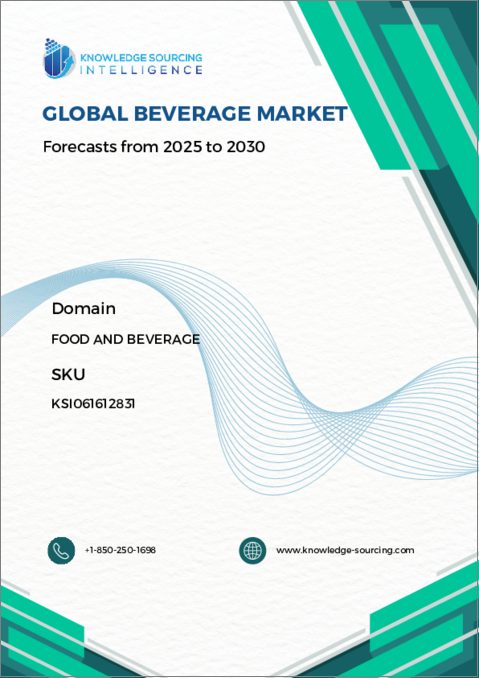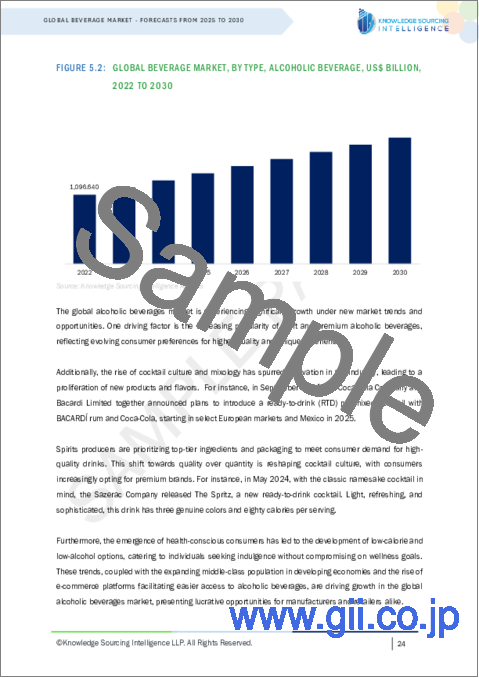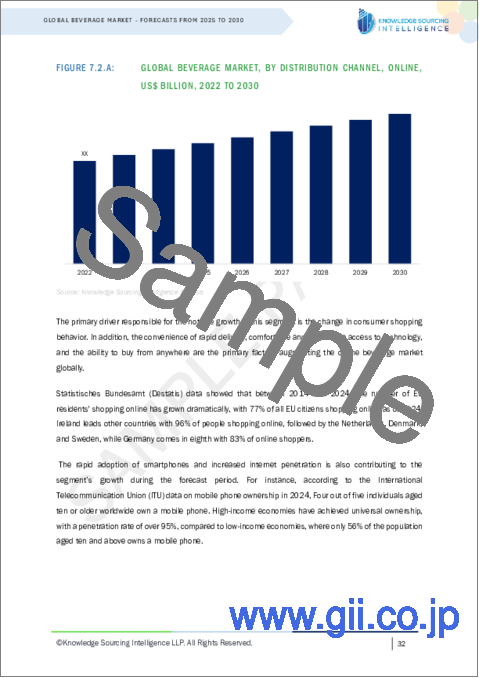|
|
市場調査レポート
商品コード
1627786
飲料の世界市場:予測(2025年~2030年)Global Beverage Market - Forecasts from 2025 to 2030 |
||||||
カスタマイズ可能
|
|||||||
| 飲料の世界市場:予測(2025年~2030年) |
|
出版日: 2024年12月12日
発行: Knowledge Sourcing Intelligence
ページ情報: 英文 147 Pages
納期: 即日から翌営業日
|
全表示
- 概要
- 目次
世界の飲料市場は、2025年の1兆8,886億700万米ドルからCAGR3.97%で成長し、2030年までには2兆2,944億8,100万米ドルに達すると推定されます。
飲料市場は、特に新興経済諸国において、消費者選好がRTD飲料にシフトしているため、予測期間を通じて緩やかな成長が見込まれます。
加えて、一人当たりのアルコール飲料消費量の増加と高級品に対する消費者の選好が、おそらく市場成長の原動力になると思われます。
さらに、生活習慣病の蔓延による健康志向の高まりや可処分所得の増加により、顧客はより健康的な飲料を選ぶようになっています。例えば、米国経済分析局によると、個人の可処分所得は2022年の5万7,577米ドルから2023年には6万1,242米ドルに増加しています。また、特にミレニアル世代やベビーブーマー世代を中心に、アルコール度数の低い飲料に対する需要が高まっています。選好性の高い幅広い製品が入手可能になったことで、低アルコール飲料の売上が増加し、顧客は好みに合った製品を選びやすくなりました。
さらに、パッケージ飲料の糖分含有量に対する健康上の懸念が高まっていることから、最終的には糖分含有量の少ないフルーツ系飲料の需要が増加する可能性があります。例えば、米国疾病対策予防センターによると、世界で3,840万人が糖尿病を患っており、18歳以上の成人9,760万人が糖尿病予備軍です。
さらに、エストニア社会省によると、絶対的アルコール含有量に基づき、2022年にエストニア国民が成人1人当たり平均11.2リットル(3米ガロン、2.5英ガロン)のアルコールを飲みました。ビール、ワイン、その他の穏やかなアルコール飲料の消費量もわずかに増加していますが、消費量増加の主因はウィスキー、ジン、リキュールなどの強いアルコール飲料の増加です。
世界の飲料市場の成長促進要因
- フルーツ系飲料の採用増加
より健康的な内容でフルーツをベースにしたものなど、新しいノンアルコール製品の採用は、飲料メーカーに大きな収益をもたらすと予想されます。例えば、Tata Consumer Products (TCPL)は2022年10月、子会社のNourishCoを通じてFruski Juice N Jellyドリンクを発売し、フルーツベースの飲料分野に参入しました。この新しい採用は、NourishCoの製品ポートフォリオを拡大し、ノンアルコール飲料カテゴリーで著名なプレーヤーになるという目標に沿ったものです。インドのRTDセクターは非常にサービスが遅れています。
ノーブランドのジュースやエスニック飲料がこの分野を支配しています。同社はこの分野に大きな可能性を見出し、Tata Fruskiブランドでジュースとエスニック飲料の分野に参入する意向です。さらに2022年12月、Fresh Del Monteはスコットランドを拠点とする飲料メーカー、Old Tom Ginと共同でエナジードリンクのラインをデビューさせました。A Kick of Fruitラインの飲料には、実際の果汁が20%以上含まれ、砂糖は無添加です。
さらに、よりヘルシーでフルーツをベースにしたものなど、新しいノンアルコール製品の採用は、飲料メーカーに大きな収益をもたらすと期待されています。さらに、インドのRTD市場は驚くほど未発達です。ブランドのないジュースやエスニック飲料が市場をリードしています。
世界の飲料市場の地理的展望
北米地域は、ノンアルコール飲料に対する消費者の選好の変化により、予測期間中に大きな成長が見込まれます。
さらに、乳糖不耐症や乳製品アレルギーが一般的になるにつれて、植物性飲料の人気が高まっています。北米市場における飲料市場の成長を後押ししている主な要因は、同地域で飲食品のオフラインおよびオンライン小売販売が増加していることです。北米には、Coca-Cola Company、PepsiCo、Redbull、Keurig Dr Pepperなどの大手飲料メーカーもあります。
植物性ミルク、エナジードリンク、機能性飲料、無糖飲料など、より健康的で持続可能な飲料を求める傾向が続いています。便利で外出先でも飲める飲料オプションに対する需要の高まりが見られ、予測期間中の市場成長を促進すると予想されます。例えば、リンゴ酢製品のメーカーとして知られるBragg Live Food Productsとガラス容器の大手メーカーであるArdagh Groupは、リンゴ酢飲料のラインアップに新しい16オンスガラスボトルを導入するための提携を発表しました。
より健康的で機能的な飲料へのニーズが世界の飲料市場の成長を牽引すると予想され、可処分所得の増加や消費者の選好の変化により、新興国のマーケットプレースは上昇を続けると思われます。技術開発、戦略的進歩、急速な都市化が市場の拡大と多様化をさらに促進すると予想されます。例えば、2023年1月、植物性市場のパイオニアであるDanone North Americaは、新商品「シルク・モカ・アーモンド・クリーマー」と「ソー・デリシャス・デイリーフリー・フレンチバニラ・ココナッツミルク・クリーマー」を発売し、この拡大に対応して植物性クリーマー部門を強化しています。
本レポートを購入する理由
- 洞察に満ちた分析:顧客セグメント、政府政策と社会経済要因、消費者の選好、産業別、その他のサブセグメントに焦点を当て、主要地域だけでなく新興地域もカバーする詳細な市場考察を得ることができます。
- 競合情勢:世界の主要企業が採用する戦略的作戦を理解し、正しい戦略で市場浸透の可能性を理解することができます。
- 市場動向と促進要因:ダイナミックな要因と極めて重要な市場動向、そしてそれらが今後の市場展開をどのように形成していくかを探ります。
- 実行可能な提言:ダイナミックな環境の中で新たなビジネスストリームと収益を発掘するための戦略的決断を下すために、洞察を活用します。
- 幅広い利用者に対応:新興企業、研究機関、コンサルタント、中小企業、大企業にとって有益で費用対効果に優れています。
どのような用途で利用されていますか?
業界と市場考察、事業機会評価、製品需要予測、市場参入戦略、地理的拡大、設備投資の決定、規制の枠組みと影響、新製品開拓、競合の影響
調査範囲
- 2022年から2030年までの実績データと予測
- 成長機会、課題、サプライチェーンの展望、規制枠組み、顧客行動、動向分析
- 競合のポジショニング、戦略、市場シェア分析
- 収益の成長と予測国別を含むセグメントおよび地域の分析
- 企業プロファイリング(戦略、製品、財務状況、主な発展など)
世界の飲料市場は以下のセグメントに分析されます:
タイプ別
- アルコール飲料
- ノンアルコール飲料
- ボトル入り飲料水
- 炭酸飲料
- フルーツジュース
- 牛乳
- 乳製品
- アーモンド
- 大豆
- 米
- オート麦
- カシューナッツ
- ココナッツ
- その他
包装タイプ別
- 缶
- 瓶
- その他
- 流通チャネル
- オンライン
- オフライン
- スーパーマーケット
- 百貨店
- コンビニエンスストア・個人商店
- フードサービス
地域別
- 北米
- 米国
- カナダ
- メキシコ
- 南米
- ブラジル
- アルゼンチン
- その他
- 欧州
- 英国
- ドイツ
- フランス
- イタリア
- その他
- 中東・アフリカ
- サウジアラビア
- UAE
- その他
- アジア太平洋
- 中国
- 日本
- インド
- 韓国
- 台湾
- タイ
- インドネシア
- その他
目次
第1章 イントロダクション
- 市場概要
- 市場の定義
- 調査範囲
- 市場セグメンテーション
- 通貨
- 前提条件
- 基準年と予測年のタイムライン
- 利害関係者にとっての主なメリット
第2章 調査手法
- 調査デザイン
- 調査プロセス
第3章 エグゼクティブサマリー
- 主な調査結果
第4章 市場力学
- 市場促進要因
- 市場抑制要因
- ポーターのファイブフォース分析
- 業界バリューチェーン分析
- アナリストビュー
第5章 世界の飲料市場:タイプ別
- イントロダクション
- アルコール飲料
- ノンアルコール飲料
- ボトル入り飲料水
- 炭酸飲料
- 果汁
- 牛乳
第6章 世界の飲料市場:包装タイプ別
- イントロダクション
- 缶
- ボトル
- その他
第7章 世界の飲料市場:流通チャネル別
- イントロダクション
- オンライン
- オフライン
- スーパーマーケット
- 百貨店
- コンビニエンスストア・個人商店
- フードサービス
第8章 世界の飲料市場:地域別
- イントロダクション
- 北米
- タイプ別
- 包装タイプ別
- 流通チャネル別
- 国別
- 南米
- タイプ別
- 包装タイプ別
- 流通チャネル別
- 国別
- 欧州
- タイプ別
- 包装タイプ別
- 流通チャネル別
- 国別
- 中東・アフリカ
- タイプ別
- 包装タイプ別
- 流通チャネル別
- 国別
- アジア太平洋
- タイプ別
- 包装タイプ別
- 流通チャネル別
- 国別
第9章 競合環境と分析
- 主要企業と戦略分析
- 市場シェア分析
- 合併、買収、合意、コラボレーション
- 競合ダッシュボード
第10章 企業プロファイル
- The Coca-Cola Company
- Nestle
- Pepsi Co Inc.
- Jones Soda Co.
- Appalachia Brewing Company
- GCMMF(Amul)
- Keurig Dr Pepper Inc.
- Bacardi Limited
- Carlsberg Breweries A/S
- Heineken N.V.(United Breweries Group)
- Brown-Forman Corporation
- Redbull
- Suntory Holdings Limited
- Constellation Brands Inc.
- Inbrew Holdings Pte Ltd(Molson Coors Brewing Company)
- VINUT(Nam Viet Foods & Beverage Joint Stock Company)
The global beverages market is estimated to reach US$2,294.481 billion by 2030, growing at a CAGR of 3.97%, from US$1,888.607 billion in 2025.
The beverage market is anticipated to witness modest growth throughout the forecast period due to shifting consumer preferences towards ready-to-drink beverages, particularly in developing and emerging economies.
Additionally, growing alcoholic beverage consumption per capita and consumer preferences for high-end goods will probably drive market growth.
Furthermore, customers are choosing healthier drinks as a result of growing lifestyle disease prevalence increased health consciousness, and rising disposable income. For instance, according to the U.S. Bureau of Economic Analysis, personal disposable income increased from US$57,577 in 2022 to US$61,242 in 2023. In addition, the market is seeing a rise in the demand for beverages with low alcohol content by volume, particularly from millennials and baby boomers. The availability of a wider range of products with better tastes has increased the sales of low-alcohol drinks and made it easier for customers to choose products that suit their preferences.
Additionally, growing health concerns about the sugar content of packaged beverages may eventually lead to an increase in demand for fruit-based beverages with lower sugar content. For instance, as per the Centers for Disease Control and Prevention, 38.4 million people worldwide have diabetes, while 97.6 million adults who are at least 18 years old have prediabetes.
Furthermore, according to the Estonian Ministry of Social Affairs, based on absolute alcohol content, Estonian citizens drank an average of 11.2 liters (three US gallons; 2.5 imperial gallons) of alcohol per adult in 2022. A small increase in the consumption of beer, wine, and other mild alcoholic beverages was also present, but the main cause of the increase in consumption was the increase in strong alcoholic beverages like whisky, gin, and liqueur.
Global beverages market growth drivers
- Increasing adoption of fruit-based beverages
The introduction of new non-alcoholic products, such as those with healthier content and based on fruits, is expected to generate significant revenues for the beverage manufacturers. For instance, Tata Consumer Products (TCPL) joined the fruit-based drinks sector in October 2022 with the launch of Fruski Juice N Jelly drink through its subsidiary NourishCo. The new introduction is in keeping with NourishCo's goal of expanding its product portfolio and becoming a prominent player in the non-alcoholic beverages category. India's ready-to-drink sector is greatly underserved.
Unbranded juices and ethnic beverages dominate the sector. The corporation identified enormous potential in this area and intends to enter the juices and ethnic beverages space with the Tata Fruski brand. In addition, in December 2022, Fresh Del Monte debuted a line of energy drinks in conjunction with Scotland-based beverage maker, Old Tom Gin. The beverages in the 'A Kick of Fruit' line include at least 20% actual fruit juice and no added sugar.
Furthermore, the introduction of new non-alcoholic products, such as those with healthier content and based on fruits, is expected to generate significant revenues for the beverage manufacturers. Furthermore, the ready-to-drink market in India is incredibly underdeveloped. Juices without brands and ethnic drinks are the market leaders.
Global beverages market geographical outlook
The North American region is anticipated to grow at a significant rate in the forecast period due to the shifting consumer preference for non-alcoholic beverages.
Furthermore, plant-based beverages became more popular as lactose intolerance and dairy allergies became more common. The major factor propelling the growth of the beverage market in the North American market is the increasing offline and online retail sales of food and beverage products in the region. North America is also home to some of the biggest beverage-producing companies, like the Coca-Cola Company, PepsiCo, Redbull, and Keurig Dr Pepper among many others.
There is an ongoing trend towards healthier and more sustainable beverage options like plant-based milk, energy drinks, functional beverages, and sugar-free drinks. An increasing demand for convenient and on-the-go beverage options is being witnessed which is expected to drive the market growth over the forecast period. For instance, Bragg Live Food Products, a well-known producer of apple cider vinegar products, and Ardagh Group, a leading producer of glass containers, announced a partnership to introduce a new 16oz glass bottle for its line of apple cider vinegar beverages.
The need for healthier and more functional beverages is expected to drive the global beverage market's growth, and emerging countries' marketplaces will continue to rise due to increased disposable incomes and shifting consumer tastes. Technological developments, strategic advances, and rapid urbanization are anticipated to drive market expansion and diversification even further. For instance, in January 2023, Danone North America, a pioneer in the plant-based market, is boosting the plant-based creamer section in response to this expansion by introducing the new Silk Mocha Almond Creamer and So Delicious Dairy Free French Vanilla Coconutmilk Creamer.
Reasons for buying this report:-
- Insightful Analysis: Gain detailed market insights covering major as well as emerging geographical regions, focusing on customer segments, government policies and socio-economic factors, consumer preferences, industry verticals, other sub- segments.
- Competitive Landscape: Understand the strategic maneuvers employed by key players globally to understand possible market penetration with the correct strategy.
- Market Drivers & Future Trends: Explore the dynamic factors and pivotal market trends and how they will shape up future market developments.
- Actionable Recommendations: Utilize the insights to exercise strategic decision to uncover new business streams and revenues in a dynamic environment.
- Caters to a Wide Audience: Beneficial and cost-effective for startups, research institutions, consultants, SMEs, and large enterprises.
What do businesses use our reports for?
Industry and Market Insights, Opportunity Assessment, Product Demand Forecasting, Market Entry Strategy, Geographical Expansion, Capital Investment Decisions, Regulatory Framework & Implications, New Product Development, Competitive Intelligence
Report Coverage:
- Historical data & forecasts from 2022 to 2030
- Growth Opportunities, Challenges, Supply Chain Outlook, Regulatory Framework, Customer Behaviour, and Trend Analysis
- Competitive Positioning, Strategies, and Market Share Analysis
- Revenue Growth and Forecast Assessment of segments and regions including countries
- Company Profiling (Strategies, Products, Financial Information, and Key Developments among others)
Global Beverages Market is analyzed into the following segments:
By Type
- Alcoholic Beverages
- Non-Alcoholic Beverages
- Bottled Water
- Carbonated Soft Drinks
- Fruit Juice
- Milk
- Dairy
- Almond
- Soy
- Rice
- Oat
- Cashew
- Coconut
- Others
By Packaging Type
- Cans
- Bottles
- Others
- Distribution Channel
- Online
- Offline
- Supermarkets
- Departmental Stores
- Convenience and Independent Stores
- Foodservice
By Geography
- North America
- USA
- Canada
- Mexico
- South America
- Brazil
- Argentina
- Others
- Europe
- United Kingdom
- Germany
- France
- Italy
- Others
- Middle East and Africa
- Saudi Arabia
- UAE
- Others
- Asia Pacific Region
- China
- Japan
- India
- South Korea
- Taiwan
- Thailand
- Indonesia
- Others
TABLE OF CONTENTS
1. INTRODUCTION
- 1.1. Market Overview
- 1.2. Market Definition
- 1.3. Scope of the Study
- 1.4. Market Segmentation
- 1.5. Currency
- 1.6. Assumptions
- 1.7. Base and Forecast Years Timeline
- 1.8. Key benefits for the stakeholders
2. RESEARCH METHODOLOGY
- 2.1. Research Design
- 2.2. Research Process
3. EXECUTIVE SUMMARY
- 3.1. Key Findings
4. MARKET DYNAMICS
- 4.1. Market Drivers
- 4.2. Market Restraints
- 4.3. Porter's Five Forces Analysis
- 4.3.1. Bargaining Power of Suppliers
- 4.3.2. Bargaining Power of Buyers
- 4.3.3. The Threat of New Entrants
- 4.3.4. Threat of Substitutes
- 4.3.5. Competitive Rivalry in the Industry
- 4.4. Industry Value Chain Analysis
- 4.5. Analyst View
5. GLOBAL BEVERAGES MARKET BY TYPE
- 5.1. Introduction
- 5.2. Alcoholic Beverages
- 5.3. Non-Alcoholic Beverages
- 5.3.1. Bottled Water
- 5.3.2. Carbonated Soft Drinks
- 5.3.3. Fruit Juice
- 5.3.4. Milk
- 5.3.4.1. Dairy
- 5.3.4.2. Almond
- 5.3.4.3. Soy
- 5.3.4.4. Rice
- 5.3.4.5. Oat
- 5.3.4.6. Cashew
- 5.3.4.7. Coconut
- 5.3.4.8. Others
6. GLOBAL BEVERAGES MARKET BY PACKAGING TYPE
- 6.1. Introduction
- 6.2. Cans
- 6.3. Bottles
- 6.4. Others
7. GLOBAL BEVERAGES MARKET BY DISTRIBUTION CHANNEL
- 7.1. Introduction
- 7.2. Online
- 7.3. Offline
- 7.3.1. Supermarkets
- 7.3.2. Departmental Stores
- 7.3.3. Convenience and Independent Stores
- 7.3.4. Foodservice
8. GLOBAL BEVERAGES MARKET BY GEOGRAPHY
- 8.1. Introduction
- 8.2. North America
- 8.2.1. By Type
- 8.2.2. By Packaging Type
- 8.2.3. By Distribution Channel
- 8.2.4. By Country
- 8.2.4.1. United States
- 8.2.4.2. Canada
- 8.2.4.3. Mexico
- 8.3. South America
- 8.3.1. By Type
- 8.3.2. By Packaging Type
- 8.3.3. By Distribution Channel
- 8.3.4. By Country
- 8.3.4.1. Brazil
- 8.3.4.2. Argentina
- 8.3.4.3. Others
- 8.4. Europe
- 8.4.1. By Type
- 8.4.2. By Packaging Type
- 8.4.3. By Distribution Channel
- 8.4.4. By Country
- 8.4.4.1. United Kingdom
- 8.4.4.2. Germany
- 8.4.4.3. France
- 8.4.4.4. Italy
- 8.4.4.5. Others
- 8.5. Middle East and Africa
- 8.5.1. By Type
- 8.5.2. By Packaging Type
- 8.5.3. By Distribution Channel
- 8.5.4. By Country
- 8.5.4.1. Saudi Arabia
- 8.5.4.2. UAE
- 8.5.4.3. Others
- 8.6. Asia Pacific
- 8.6.1. By Type
- 8.6.2. By Packaging Type
- 8.6.3. By Distribution Channel
- 8.6.4. By Country
- 8.6.4.1. China
- 8.6.4.2. Japan
- 8.6.4.3. India
- 8.6.4.4. South Korea
- 8.6.4.5. Taiwan
- 8.6.4.6. Thailand
- 8.6.4.7. Indonesia
- 8.6.4.8. Others
9. COMPETITIVE ENVIRONMENT AND ANALYSIS
- 9.1. Major Players and Strategy Analysis
- 9.2. Market Share Analysis
- 9.3. Mergers, Acquisitions, Agreements, and Collaborations
- 9.4. Competitive Dashboard
10. COMPANY PROFILES
- 10.1. The Coca-Cola Company
- 10.2. Nestle
- 10.3. Pepsi Co Inc.
- 10.4. Jones Soda Co.
- 10.5. Appalachia Brewing Company
- 10.6. GCMMF (Amul)
- 10.7. Keurig Dr Pepper Inc.
- 10.8. Bacardi Limited
- 10.9. Carlsberg Breweries A/S
- 10.10. Heineken N.V. (United Breweries Group)
- 10.11. Brown-Forman Corporation
- 10.12. Redbull
- 10.13. Suntory Holdings Limited
- 10.14. Constellation Brands Inc.
- 10.15. Inbrew Holdings Pte Ltd (Molson Coors Brewing Company)
- 10.16. VINUT (Nam Viet Foods & Beverage Joint Stock Company)





